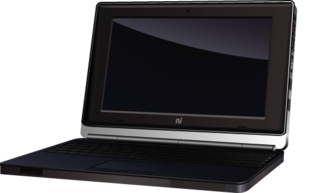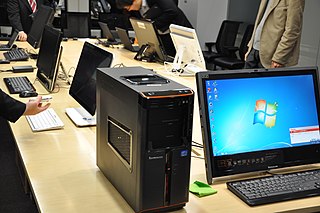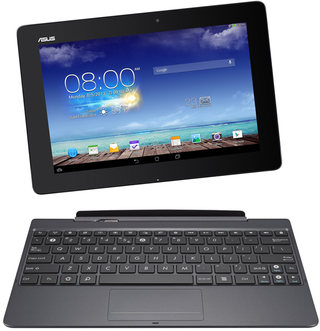
ThinkPad is a line of business-oriented laptop computers and tablets, the early models of which were designed, developed and marketed by IBM, starting in 1992. In 2005 IBM sold its PC business, including laptops to Lenovo. The Chinese manufacturer further developed the line, and is still selling new models in 2023.

IdeaPad is a line of consumer-oriented laptop computers designed, developed and marketed by Lenovo. The IdeaPad mainly competes against computers such as Acer's Aspire, Dell's Inspiron and XPS, HP's Pavilion, Envy and Stream, Samsung's Sens and Toshiba's Satellite.

The Touch Book is a portable computing device that functions as a netbook, and a tablet computer. Designed by Always Innovating, a company situated in the city of Menlo Park, in California, USA, it was launched at the DEMO conference in March 2009. Its designers stated at launch that it is the first netbook featuring a detachable keyboard with a long battery life. It is based on the ARM TI OMAP3530 processor and features a touchscreen.

The Asus Eee Pad Transformer TF101 is a 2-in-1 detachable tablet developed by Asus that runs the Android operating system. It is the first tablet in the Asus Transformer Pad series. The Eee Pad Transformer features a 10.1-inch (260 mm) display, an Nvidia Tegra 2 dual-core chip, 1 GB of RAM, and 16 or 32 GB of storage. The tablet initially launched with Android 3.1, nicknamed "Honeycomb", but was updated to support Android 4.0.3.

The ThinkPad X series is a line of laptop computers and convertible tablets produced by Lenovo with less power than its other counterparts. It was initially produced by IBM until 2005.

The IdeaPad S Series is a series of notebook computers launched by Lenovo in October 2008. The IdeaPad S10 was initially scheduled for launch in September, but its release was delayed in the United States until October.

The Lenovo IdeaCentre is a line of consumer-oriented desktop computers designed, developed and marketed by Lenovo. The first IdeaCentre desktop, the IdeaCentre K210, was announced by Lenovo on June 30, 2008 as a consumer-focussed alternative to the business-oriented ThinkCentre and ThinkStation brandnames acquired from IBM. While the IdeaCentre line consists entirely of desktops, they share a common design language with the IdeaPad line of laptops and hybrids. One such feature is Veriface facial recognition technology.
Lenovo smart televisions use the Android operating system and are marketed as the "LeTV" in Mainland China.
The IdeaPad tablets from Lenovo were a brand of consumer-oriented tablet computers designed for home use or entertainment, as opposed to the business-focused ThinkPad Tablet series. Devices sold in certain countries, such as China, India and New Zealand, were sold under the LePad brand, similar to the LePhone series of smartphones. IdeaPad-branded tablets have been produced with the Android and Windows operating systems.

Lenovo Yoga is a line of consumer-oriented laptop computers and tablets designed, developed and marketed by Lenovo, named for their ability to assume multiple form factors due to a hinged screen.

The ThinkPad Tablet 2 is a tablet computer announced in 2012 and released by Lenovo in 2013.
The ThinkPad Twist is a 2-in-1 convertible tablet, that can function as a laptop and tablet released in 2012. The Twist is designed for business users and runs Microsoft's Windows 8 operating system.
The Lenovo IdeaPad Yoga 11 is a hybrid laptop/tablet Windows RT-based computer released in late 2012. The Yoga 11 gets its name from its ability to change form factors thanks to the two-way hinge used to mount its display. It was discontinued on July 17, 2013, due to the poor sales of Windows RT devices.
The Lenovo Miix was a series of multi-mode computing devices that function as both a tablet and a notebook computer.

The ThinkPad Yoga is a 2-in-1 convertible business-oriented tablet from Lenovo unveiled in September at the 2013 IFA in Berlin, Germany. It was released in the United States in November 2013.

The LenovoIdeaPad Flex is a 2-in-1-laptop line by Lenovo. Unlike the Lenovo IdeaPad Yoga line of devices, the keyboard does not bend back entirely to allow use as a tablet, it is only a dual-mode laptop. Its keyboard rotates behind the display in order to put the device into "stand mode." Stand mode brings the user closer to the screen for watching videos and using touch-enabled apps and removes the visual distraction from the keyboard.
The ThinkPad 8 is a business-oriented tablet computer with an eight-inch touchscreen, released by Lenovo in January 2014. It is one of the Lenovo's first Windows-based small-screen tablet devices, along with the Lenovo Miix 2, and also one of the first with a high-resolution full HD display. Along with the first-generation ThinkPad 10, it is part of the third generation of ThinkPad-branded tablets, succeeding the ThinkPad Tablet 2.
Lenovo ThinkPad 10 refers to two generations of 10-inch business-oriented tablet computers manufactured by Lenovo.

The Asus Transformer Pad TF701T is an Android tablet computer made by Asus, successor to the Asus Transformer Pad Infinity. The Transformer design includes a docking keyboard. The Asus Transformer Pad TF701T was released in the UK in October 2013 and in the U.S. in November 2013.

The Phab 2 Pro is an Android smartphone in a phablet form factor, developed and produced by Lenovo and first released in November of 2016 at an MSRP of US$499. The device is notable for being the first consumer smartphone to support Google Tango augmented reality (AR) technology.


















